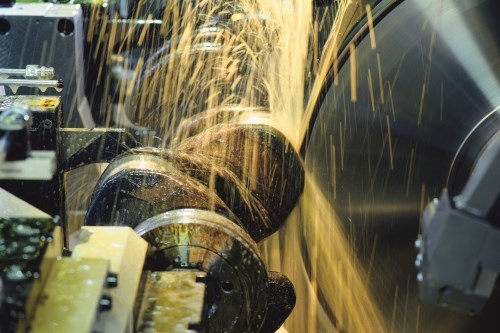Large-Part Grinding: Two Key Technologies
Developments in steady rest and in-process measurement technologies enable effective grinding of huge crankshafts.
Share






Advances in steady rest and in-process measurement technologies enable large crankshafts to be ground complete in one setup.
, manufacturer of high-speed CBN grinding machines, has developed its new JuCrank series for cylindrical and non-cylindrical grinding for large crankshafts. The series offers a swing diameter of 470 mm and a part length capacity of up to 4.8 m, and can accommodate crankshafts that can weigh as much as 1,000 kg. Because these parts are so big and unwieldy, the company integrated two technologies to streamline setup and processing.
First, Junker developed its own steady rest system, believing that existing systems were too bulky and not rigid enough for high-speed grinding. These new steadies are CNC-controlled and have only one axis each, which is said to increase their stability and stiffness. A maximum of 11 steadies can be controlled individually and applied to a section at any time—even during the grinding process—to enable higher sequence flexibility.
Second, the company integrated an in-process measurement system. That’s because large crankshafts are mainly produced in small batches (in some cases as single pieces), and the forging and hardening costs are so high that scrapping a part is not an option.
To start the crankshaft grinding process, the machine’s two wheels, each mounted on a wheelhead with its own X and Z axis, pre-grind the main and pin bearings. Those diameters are measured during the process, and then the entire workpiece is measured after pre-grinding, including features such as the taper of each element, the bearing widths and lift heights.
Based on the measuring data, the machine completes the grinding process while using the WK axis whereby the grinding spindle swivels to compensate for tapers. The machine can also provide each main and pin bearing with its own profile shape with specific crowning. If necessary, the shaft ends can also be ground, which also often feature a taper. As a result, the crankshaft is ground complete in one setup.
Another application for the JuCrank machines is re-grinding of used crankshafts, whereby the crankshafts are ground based upon the measurements taken by the machine. This grinding platform also can be effective for other large-scale applications, such as printing rollers and electric motor shafts.
Related Content
-
Seeking Custom Grinding and Automation with Weldon Solutions
Weldon Solutions is demonstrating three grinders at IMTS 2024. Though they differ in size and use case, all feature the company’s hallmark customizations.
-
Vollmer Grinding Machine Features Double-Spindle Design
Eastec 2023: VGrinds are said to be suitable for machining rotary tools made from carbide, such as drills, milling cutters or reamers.
-
Kaast Machine Tools' Solutions Enable Precise, Efficient Machining
IMTS 2024: Kaast Machine Tools Inc. is performing live demonstrations of several of its manufacturing solutions, including a vertical machining center, a cold saw and more.
















